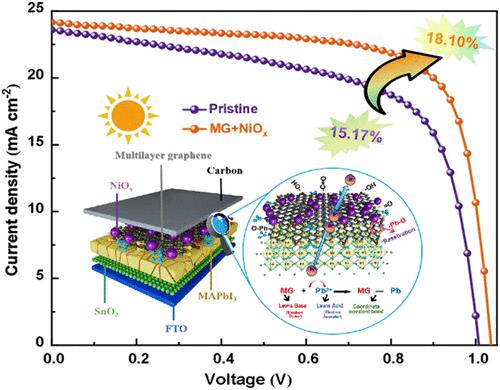Mechanism Investigation of the Synergistically Enhanced Performance of Carbon-Based Perovskite Solar Cells Utilizing Coal-Derived Multilayer Graphene with NiOx
IF 8.2
2区 材料科学
Q1 MATERIALS SCIENCE, MULTIDISCIPLINARY
引用次数: 0
Abstract
The efficiency of carbon-based perovskite solar cells (C-PSCs) still significantly lags behind that of metal-based devices due to the substantial interfacial resistance and energy level mismatch between the carbon electrodes (CE) and the perovskite material. Herein, we present the construction of a carrier highway utilizing coal-derived multilayered graphene (MG) embedded with NiOx as a hole-transport layer (HTL). This approach aims to optimize energy level alignment and enhance interfacial contact, thereby improving the quality of the perovskite film. Due to its unique multilayer structure and abundant oxygen-containing functional groups, coal-derived MG synergized with NiOx HTL not only provides well-aligned energy band configurations that facilitate charge separation and extraction but also acts as a Lewis base to form coordination bonds with uncoordinated lead ions by sharing electron pairs, thereby reducing surface defects and minimizing recombination losses at the perovskite/CE interface, ultimately alleviating fill factor (FF) loss. As a result, the power conversion efficiency (PCE) of the FTO/SnO2/MAPbI3/MG + NiOx/Carbon structured device achieved 18.10%, representing a significant enhancement of 19.3% compared to that of 15.17% for the pristine device. This study presents a novel strategy for enhancing the overall performance of C-PSCs through the utilization of cost-effective and environmentally sustainable carbon functional materials derived from coal.

煤衍生多层石墨烯与氧化镍协同增强碳基钙钛矿太阳能电池性能的机理研究
碳基钙钛矿太阳能电池(C-PSCs)的效率仍然明显落后于金属基器件,这是由于碳电极(CE)和钙钛矿材料之间存在大量的界面电阻和能级不匹配。在此,我们提出了利用煤衍生的多层石墨烯(MG)嵌入NiOx作为空穴传输层(HTL)来构建载体高速公路。该方法旨在优化能级排列和增强界面接触,从而提高钙钛矿膜的质量。煤源MG由于其独特的多层结构和丰富的含氧官能团,与NiOx HTL协同作用,不仅提供了排列良好的能带构型,便于电荷分离和提取,而且作为路易斯碱,通过共享电子对与不配位的铅离子形成配位键,从而减少了钙钛矿/CE界面的表面缺陷,最大限度地减少了复合损失,最终减轻了填充因子(FF)损失。结果表明,FTO/SnO2/MAPbI3/MG + NiOx/Carbon结构器件的功率转换效率(PCE)达到18.10%,比原始器件的15.17%提高了19.3%。本研究提出了一种新的策略,通过利用来自煤炭的具有成本效益和环境可持续性的碳功能材料来提高C-PSCs的整体性能。
本文章由计算机程序翻译,如有差异,请以英文原文为准。
求助全文
约1分钟内获得全文
求助全文
来源期刊

ACS Applied Materials & Interfaces
工程技术-材料科学:综合
CiteScore
16.00
自引率
6.30%
发文量
4978
审稿时长
1.8 months
期刊介绍:
ACS Applied Materials & Interfaces is a leading interdisciplinary journal that brings together chemists, engineers, physicists, and biologists to explore the development and utilization of newly-discovered materials and interfacial processes for specific applications. Our journal has experienced remarkable growth since its establishment in 2009, both in terms of the number of articles published and the impact of the research showcased. We are proud to foster a truly global community, with the majority of published articles originating from outside the United States, reflecting the rapid growth of applied research worldwide.
 求助内容:
求助内容: 应助结果提醒方式:
应助结果提醒方式:


